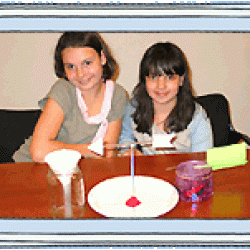Source Institutions
Source Institutions
Add to list Go to activity
Activity link broken? See if it's at the internet archive

This three-part activity shows learners how to build three meteorology tools: a wind vane, a rain gauge, and a barometer. Then, they can use their tools to build their own weather station to record data about the weather, study the data to detect patterns, and use the patterns to predict the weather. This lesson also includes information about the difference between weather and climate.
- Under 5 minutes
- 1 to 7 days
- $1 - $5 per student
- Ages 8 - 14
- Activity
- English
Quick Guide
Materials List (per student)
- paper plate
- marker
- compass (for telling direction)
- printout of wind vane cutouts (PDF)
- cardboard or folder
- straight pin
- scissors
- clear tape
- sharpened pencil with a new eraser
- plastic drinking straw
- modeling clay
- printout of your Weather Chart
- tall, clear jar with straight sides, at least 2 inches high. Most spaghetti sauce jars are good.
- funnel (with an opening about the same size as the jar's base)
- plastic ruler
- clear tape or masking tape
- permanent marker
- small coffee can
- plastic wrap
- 2 straws (one flexible and one straight)
- ruled index card
- rubber band
Subjects
-
Earth and Space Science
-
Earth Processes
- Weather and Climate
-
Earth Structure
- Atmosphere
-
Earth Processes
-
Mathematics
-
Algebra
- Patterns
-
Data Analysis and Probability
- Data Analysis
- Data Collection
- Data Representation
- Probability
- Measurement
- Reasoning and Proof
- Representation
-
Algebra
-
The Nature of Science
-
The Scientific Process
- Conducting Investigations
- Gathering Data
- Formulating Explanations
- Communicating Results
- Science as a Career
-
The Scientific Process
Informal Categories
- Nature and Environment
- Outdoor Activity
Audience
To use this activity, learners need to:
- see
- read
- be mobile
- touch
Learning styles supported:
- Involves hands-on or lab activities
Other
This resource is part of:
Access Rights:
- Free access
By:
Source Collection
- Ology
Rights:
- All rights reserved, American Museum of Natural History,
